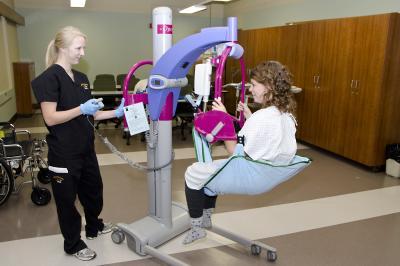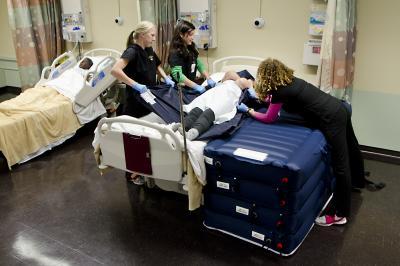COLUMBIA, Mo. – Nursing is among construction and law enforcement as one of seven professions reporting the most on-the-job injuries, according to the U.S. Department of Labor. Sprains, strains or tears due to overexertion account for many of the injuries. Those injuries often can be attributed to improperly lifting, handling and moving patients. Now, nursing students at the University of Missouri have a new facility that will help them develop skills to keep themselves and their patients safe.
An unused locker room in the Sinclair School of Nursing has been transformed into the nursing safe practices room, funded by a $300,000 donation from an anonymous donor. Part of the Essig Simulation Lab, the safe practices room provides spaces for students to practice communication "handoffs," medication safety and lifting and moving patients. The room features a bariatric (obese) mannequin and patient transfer stations with specialized lifting equipment. Bathroom and shower facilities provide additional space for students to learn how to safely transfer patients.
"Hospitals conduct safety simulations with nurses using similar facilities," said Gretchen Gregory, an instructor of nursing. "Now we can use the safe practices room to do simulations with students before they enter the field."
Emelia Fujita, a senior nursing student, said the room will help familiarize students with equipment and procedures. She said continued practice in the room will help make prevention of errors second nature to the students.
"Incorporating the safe practices room into the curriculum goes beyond teaching

An MU nursing student practices using a lift that helps transfer patients from one chair to another.
(Photo Credit: MU)
students safe practices," Fujita said. "These students will become professionals who practice safe patient care, which will make hospitals safer for patients."
Gregory and Myra Aud, associate professor of nursing, use the room for clinical simulations with nursing students and students in other health professions, such as respiratory therapy, pharmacology and medicine. During the simulations, students work together to identify, solve and prevent safety issues.
"Everyone contributes different perspectives on safety, and they learn from the expertise of their colleagues," Aud said.
Cassie Johanningmeier, another senior nursing student, said the room benefits students because it allows them to test their safety skills without facing real-life consequences.
"One of the best ways to learn is through practice," Johanningmeier said. "The safe practices room helps students build confidence so they can prevent errors that could harm themselves or their patients."

Students in the Sinclair School of Nursing practice safely transferring a patient from an inflatable lift to a hospital bed.
(Photo Credit: MU)
Source: University of Missouri-Columbia